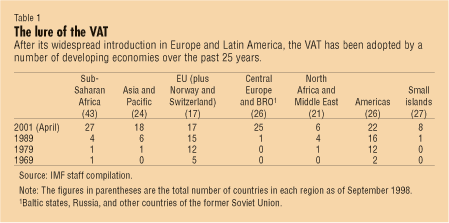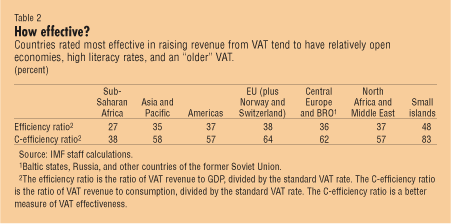 About F&D Subscribe Back Issues Write Us Copyright Information Free Email Notification Receive emails when we post new
items of interest to you. |
The Allure of the Value-Added Tax Liam Ebrill, Michael Keen, Jean-Paul Bodin, and Victoria Summers
The VAT began life in the more developed countries of Europe and Latin America but, over the past 25 years, has been adopted by a vast number of developing and transition countries. A recent IMF study concludes that the VAT can be a good way to raise resources and modernize the overall tax system—but this requires that the tax be well designed and implemented
The rapid rise of the value-added tax (VAT) was the most dramatic—and probably most important—development in taxation in the latter part of the twentieth century, and it still continues. Forty years ago, the tax was barely known outside theoretical discussions and treatises. Today, it is a key component of the tax system in over 120 countries, raising about one-fourth of the world's tax revenue. What is the VAT? It is a tax levied on all sales of commodities at every stage of production. Its defining feature is that it credits taxes paid by enterprises on their material inputs against the taxes they must levy on their own sales. Unlike a retail sales tax—under which tax is collected only at the point of sale to the final consumer—revenue is collected throughout the production process. Unlike a simple turnover tax—which levies tax on all sales, intermediate or final—producers can reclaim the tax they have been charged on their inputs. Because the VAT does not affect the prices firms ultimately pay for inputs, it does not distort production decisions and does not create "cascading"—the "tax on tax" that arises when tax is charged both on an input into some process and on the output of that same process. This also makes the effects of the VAT transparent. All firms whose annual turnover exceeds a specified threshold must participate—not only those involved in making final sales to consumers. But, in the end, only the net value of those final sales forms the base of the tax so that the VAT—if it is functioning as intended—is thus a tax on final consumption. While there are other ways in which one can try to tax consumption—such as a retail sales tax—the feature of the VAT that tax is collected throughout the production chain gives it a considerable practical advantage. Suppose Firm A sells its output (assumed, to keep the example simple, to be produced using no material inputs) for a price of $100 (excluding tax) to Firm B, which in turn sells its output for $400 (again excluding tax) to final consumers. Assume now that there is a VAT with a 10 percent rate. Firm A will then charge Firm B $110, remitting $10 to the government in tax. Firm B will charge final consumers $440, remitting tax of $30: output tax of $40 less a credit for the $10 of tax charged on its inputs. The government thus collects a total of $40 in revenue. In its economic effects, the tax is thus equivalent to a 10 percent tax on final sales (there is no tax incentive, in particular, for Firm B to change its production methods or for the two firms to merge), but the method of its collection secures the revenue more effectively. If, for some reason, Firm A were to omit charging tax to Firm B, for example, the government would still collect $40 from B (which would have no credit to set against its output tax). If Firm B omitted charging tax, the government would at least collect the $10 from A. This last observation also illustrates a key advantage of the VAT over a retail sales tax, hinted at above. Imagine now that B is a retailer, and somehow manages to avoid paying any tax. Under the VAT, the government still has the $10 paid by A; under a retail sales tax, it has nothing. Before the VAT's introduction, domestic indirect taxes were typically limited to narrowly defined products, such as alcohol and tobacco, and to sales and turnover taxes. Distortions associated with turnover taxes, combined with governments' need to increase their revenues—particularly, in many cases, to replace import tariff revenues lost as a consequence of trade liberalization—created an incentive to seek less distortionary alternatives. Countries were slow to adopt the VAT, however. Although the first proposals emerged in France in the 1920s, the first recognizable VAT did not appear until 1948, in France. Brazil was the first Latin American country to adopt the VAT, in 1967, and Denmark's adoption of the VAT that same year marked the start of the tax's widespread introduction to Europe (see Table 1). The VAT spread rapidly in the industrial world and South America until the late 1970s and was adopted by the developing and transition economies only a decade later. Remarkably, the number of African countries with a VAT increased from 2 to 30 in the 1990s. For more than 30 years, the IMF has been a critical part of the global drama, advising member countries on how to design and implement the VAT. That is why it recently undertook a major study to answer key questions about the usefulness of the tax—which has been surprisingly little studied—and to crystallize best practices. The findings were encouraging, indicating that the spread of the VAT appears to have been broadly desirable. But they also underscored that the success of a VAT cannot be taken for granted: it requires good design and implementation, not only when first adopted but also for many years after. Judging efficiency and fairness Has the VAT lived up to its early promise as an efficient, fair source of revenue? Efficiency gains associated with the use of a VAT are hard to observe directly, so we tackle this question through the indirect route of asking whether countries with a VAT tend to have a higher ratio of total tax revenues to GDP—the idea being that if a VAT does indeed reduce the efficiency cost of raising revenue, then governments with a VAT should raise more revenue. Holding other things equal—including per capita GDP and the openness of an economy—we found some evidence that the VAT is indeed associated with a higher ratio of general government revenue and grants to GDP; weaker evidence that it is associated with a higher ratio of general government tax revenue alone; and no evidence that it is associated with a higher (or lower) ratio of central government tax revenue. Although the interpretation of these results is difficult and further research is clearly needed, this finding suggests to us that the VAT may bolster revenues efficiently.
 When is the VAT most effective in raising revenue? The traditional measure of the effectiveness of the VAT in raising revenue is the "efficiency ratio"—the ratio of VAT revenue to GDP, divided by the standard VAT rate. But this measure has flaws, notably that errors in measuring GDP contaminate it. More important, the appropriate benchmark should be total consumption (the ideal VAT base), not GDP. A policy error that brought some investment into the tax base, for example, would increase the efficiency ratio even though it meant a worse VAT. We tried to avoid this problem by looking instead at the "C-efficiency ratio"—the ratio of VAT revenue to consumption, divided by the standard tax rate (see Table 2): a VAT that taxed all consumption at a uniform rate—which is the benchmark at which the IMF typically aims in making its VAT recommendations—would have C-efficiency of 100 percent. We found that factors linked with relatively high C-efficiency include
Not just for rich countries Is the VAT suitable for developing countries? The VAT is often thought to be an intrinsically complicated tax, cumbersome for both taxpayers and authorities and thus ill suited to developing countries, where even basic record-keeping ability may be limited. The key question is not, however, whether developing countries gain less from adopting the VAT than developed countries; nor is it whether the VAT performs better in countries with greater administrative sophistication—presumably true of any tax. Rather, the question is whether the VAT does worse than available alternatives in developing countries. That is, does it perform less well, taking into account the administrative and compliance costs to all participants, than other taxes that would have to be used—or were actually used—to raise similar revenues in its absence? To shed light on this, in the absence of reliable evidence on the collection costs associated with alternative taxes in developing countries, we examined six francophone and six anglophone African countries' tax systems before and after the VAT. There were many similarities among the predecessor indirect taxes (turnover taxes on the old French model and manufacturers' sales taxes in the former British colonies). These taxes had many and, frequently, narrowly differentiated rates; many specific exemptions; exemptions for retail trade; differential treatment of imports and domestic sales; and, in some cases, artificially constructed "manufacturer's prices" to form the tax base. All the taxes, in particular, had complex methods to avoid the cascading that is inherent in turnover taxes—the function neatly served by the VAT's multistage crediting method. We found that, in many developing countries, a simple VAT with a high registration threshold—the turnover level at which the tax is charged—would clearly be simpler to administer than the tax(es) that such a VAT would replace.
 Does this also hold for small countries, given that most countries still without a VAT are small, and over one-fourth are small island economies with populations of under one million? Here, too, we found that C-efficiency ratios for small countries with VATs were strikingly high, averaging 65 percent, about the same as for the European Union countries. This is consistent with the earlier observation that good VAT performance is strongly correlated with openness. But one must again ask, "good compared to what?" Just because the VAT may be the easiest tax to collect in small, open economies, that does not make it the best choice. Maybe other taxes would perform even better. To answer this, we compared the VAT with a uniform tariff on all imports, because, in the absence of collection costs, the best policy for a small economy is to levy no trade taxes but to raise revenues by taxing consumption. Rough calculations suggest that collection cost differentials would have to be quite large to outweigh the efficiency aspects of moving to a VAT. Where there are few stages in domestic production, however, the VAT may offer little gain over either a retail sales tax or, in particular, a uniform tariff. The VAT's advantages would be greater the lower the share of imports in GDP, the smaller the proportion of imported consumption, and the larger the share of intermediate goods in imports. As an economy develops, the VAT's advantages increase. Best practices in design What are the key challenges in designing a VAT? A survey of the IMF's advice and experience with VAT policy and administration in 37 countries showed that many issues in the design of the tax are not contentious. More striking, however, there were several areas in which IMF advice was consistent across countries but not fully accepted.
The threshold issue is of great practical importance, given that the low initial threshold in several countries has been cited as one of the VAT's key weaknesses. It is considered a prime reason why Ghana's VAT failed when first introduced in 1995 (at a registration level of $20,000, compared with $75,000 on its successful reintroduction in 1999). It is also one of the reasons Uganda's VAT nearly failed when it was introduced in 1996 (at $20,000, later raised to $50,000). Clearly, if there were no administrative or compliance costs, the most efficient threshold would be zero. But, of course, this is not the case. A simple rule of thumb is to set the threshold at the point where the collection costs saved are balanced against the revenues lost. Given that, in most countries, the value-added base is concentrated among relatively few firms, a high threshold is, by far, the most efficient approach. Countries seem to have resisted this for various reasons—particularly, the perception that excluding smaller firms is in some way unfair and a belief that covering more firms will bring in more revenue. While there is some truth in these concerns, they are, in our view, often outweighed by the advantages of focusing the VAT on relatively few, large taxpayers. A tool for poverty reduction Is the VAT inherently regressive or is it a powerful instrument for poverty alleviation? It is commonly feared that the VAT adversely affects the distribution of real income. But, rather than any one tax, it is the tax system as a whole, taken in conjunction with public spending policies, that affects poverty and fairness. In theory, a regressive tax could be the best way to finance pro-poor spending, which more than offsets any anti-poor effect of the tax itself. The question, of course, is how the situation plays out in practice in most developing countries with a VAT. Studies of the VAT in developing countries are still few, but there is growing evidence that the VAT is not an especially regressive tax. For example, studies for C�te d'Ivoire, Guinea, Madagascar, and Tanzania all show that the poor pay less than their share of total consumption as their share of total VAT revenues. Notably, the VAT proved more progressive than the trade taxes it often replaced. Many of those who perceive the VAT as particularly regressive are likely to be implicitly comparing it to a progressive personal income tax—a comparison of little relevance given the great difficulties that developing countries experience in administering an effective personal income tax. More generally, few taxes are well suited to pursuing equity objectives. Expenditure policies are often a far better means of achieving these aims, though the capacity for well-targeted spending measures is very limited in many low-income countries. While the scope for pursuing distributional objectives on the spending side should not be taken for granted, experience has clearly demonstrated that the first duty of taxation must normally be to raise needed revenues with as little distortion of economic activity as possible. Simple is best What are the main administrative problems? The introduction of a VAT can facilitate substantial improvements in overall tax administration, particularly the establishment of more integrated tax administration organizations and the development of modern procedures based on voluntary compliance. But there have been some significant weaknesses in the VAT's implementation in developing and transition countries:
The refund issue has become increasingly problematic in many countries in recent years. There is a troublesome tension between the importance of assuring prompt refunds—without which the VAT loses many of its economic merits—and the desire of governments to guard their revenues against fraud and the temptation they face to strengthen revenues by simply delaying refund payments. Indeed, we find that refunds are the VAT's Achilles heel. Tax policy advice in this area has been greatly influenced by tax administration constraints because adoption of best practice (which is the prompt refunding of all excess credits) is simply not possible in countries with weak administrative capacity. The lack of effective audit mechanisms is usually the primary cause of these problems, and the importance of developing such capacity may have been underappreciated in much of the advice and technical assistance on the VAT. The IMF currently tends to advise paying refunds only to exporters and, sometimes, businesses importing large quantities of capital equipment, with streamlined procedures for those with established, reliable records in their tax dealing, while imposing some delays and carry-forwards of credits on other taxpayers. Next steps for the VAT Key issues for the future will no doubt involve the VAT's implementation in decentralized states and within regional trading blocs, where there are no formal border controls; the proper treatment of the financial sector under the VAT; and reduction of the damage from multiple rates and exemptions, which are even more inconsistent with the basic logic of the VAT. A still more fundamental and as yet little recognized set of issues concerns the relationships between the VAT and income taxes, both domestically and internationally. For all the VAT's impressive achievements, its potential has still not been fully exploited or, perhaps, fully understood. This article is based on the authors' book, The Modern VAT, which was published by the IMF in 2001.
|